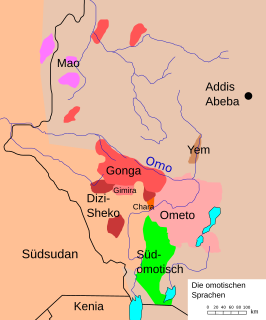Related Research Articles

Afroasiatic (Afro-Asiatic), also known as Afrasian or Hamito-Semitic, Semito-Hamitic, or Erythraean is a large language family of about 300 languages that are spoken predominantly in the Middle East, North Africa, the Horn of Africa and parts of the Sahel. With the exception of Semitic, which is also spoken in the Middle-East and in Malta, all branches of the Afroаsiatic family are spoken exclusively on the African continent.

The Chadic languages form a branch of the Afroasiatic language family. They are spoken in parts of the Sahel. They include 150 languages spoken across northern Nigeria, southern Niger, southern Chad, the Central African Republic, and northern Cameroon. The most widely spoken Chadic language is Hausa, a lingua franca of much of inland Eastern West Africa.

The Cushitic languages are a branch of the Afroasiatic language family. They are spoken primarily in the Horn of Africa, with minorities speaking Cushitic languages to the north in Egypt and the Sudan, and to the south in Kenya and Tanzania. As of 2012, the Cushitic languages with over one million speakers were Oromo, Somali, Beja, Afar, Hadiyya, Kambaata, Saho, and Sidama.

The demographics of Ethiopia encompass the demographic features of inhabitants in Ethiopia, including ethnicity, languages, population density, education level, health, economic status, religious affiliations and other aspects of the population.

The Omotic languages are a group of languages spoken in southwestern Ethiopia. The Ge'ez script is used to write some of the Omotic languages, the Latin script for some others. They are fairly agglutinative and have complex tonal systems. The languages have around 6.2 million speakers. The group is generally classified as belonging to the Afroasiatic language family, but this is disputed by some.
The Saho language is an Afro-Asiatic language spoken in Eritrea, Sudan and Ethiopia. It belongs to the family's Cushitic branch.

The Koman languages are a small close-knit family of languages located along the Ethiopia–Sudan border with about 50,000 speakers. They are conventionally classified as part of the Nilo-Saharan family. However, due to the paucity of evidence, many scholars treat it as an independent language family. Among scholars who do accept its inclusion within Nilo-Saharan, opinions vary as to their position within it.
Lowland East Cushitic is a group of roughly two dozen diverse languages of the Cushitic branch of the Afro-Asiatic family. Its largest representatives are Somali and Oromo.
Bussa, or Mossiya, is a Cushitic language spoken in the Dirashe special woreda of the Southern Nations, Nationalities, and People's Region located in southern Ethiopia. The people themselves, numbering 18,000 according to the 2007 census, call their language Mossittaata.
South Semitic is a putative branch of the Semitic languages. Semitic itself is a branch of the larger Afro-Asiatic language family found in Africa and Western Asia.
The languages of Ethiopia include the official languages of Ethiopia, its national and regional languages, a large number of minority languages, as well as foreign languages.
The main languages spoken in Eritrea are Tigrinya, Tigre, Kunama, Bilen, Nara, Saho, Afar, Beja.

Marvin Lionel Bender was an American linguist.
Arbore is an Afro-Asiatic language spoken by the Arbore people in southern Ethiopia in a few settlements of Hamer woreda near Lake Chew Bahir.
The Aroid or Ari-Banna languages possibly belong to the Afro-Asiatic family and are spoken in Ethiopia.
Dizin is an Omotic language of the Afro-Asiatic language family spoken by the Dizi people, primarily in the Maji woreda of the Southern Nations, Nationalities and Peoples Region, located in southwestern Ethiopia. The 2007 census listed 33,927 speakers. A population of 17,583 was identified as monolinguals in 1994.
Bambassi is an Omotic Afroasiatic language spoken in Ethiopia around the towns of Bambasi and Didessa in the area east of Asosa in Benishangul-Gumuz Region. The parent language group is the East Mao group. Alternative names for the language are Bambeshi, Siggoyo, Amam, Fadiro, Northern Mao, Didessa and Kere.

The Konso, also known as the Xonsita, are a Lowland East Cushitic-speaking ethnic group primarily inhabiting south-central Ethiopia.
The Mao languages are a branch of the Omotic languages spoken in Ethiopia. The group had the following categories:
Seze is an Afro-Asiatic Omotic language, spoken in the western part of Ethiopia, near the town of Begi and just north of the Hozo-speaking community.
References
- 1 2 Hozo at Ethnologue (18th ed., 2015)
- ↑ Küspert, K. C. (2015). The Mao and Komo languages in the Begi–Tongo area in Western Ethiopia: Classification, designations, distribution. Linguistic Discovery, 13(1), 1-63.
- ↑ Siebert, R., Wedekind, C., & Wedekind, K. (1994). Third SLLE survey on languages of the Begi/Asosa area. Survey of Little-Known Languages of Ethiopia (SLLE) Reports, 15, 1-19.
- 1 2 3 4 5 Rydgren, E. (2016). Omotic Languages. Salem Press Encyclopedia.